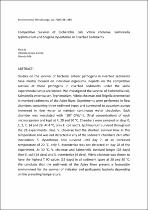 ResearchSpace
ResearchSpace
Competitive Survival of Escherichia coli, Vibrio cholerae, Salmonella typhimurium and Shigella dysenteriae in Riverbed Sediments
JavaScript is disabled for your browser. Some features of this site may not work without it.
- ResearchSpace
- →
- Research Publications/Outputs
- →
- Journal Articles
- →
- View Item
| dc.contributor.author |
Abia, AL

|
|
| dc.contributor.author |
Ubomba-Jaswa, Eunice

|
|
| dc.contributor.author |
Momba, MN

|
|
| dc.date.accessioned | 2017-07-28T09:10:09Z | |
| dc.date.available | 2017-07-28T09:10:09Z | |
| dc.date.issued | 2016-11 | |
| dc.identifier.citation | Abia, A.L.K., Ubomba-Jaswa, E. and Momba, M.N.B. 2016. Competitive Survival of Escherichia coli, Vibrio cholerae, Salmonella typhimurium and Shigella dysenteriae in Riverbed Sediments. South Africa. Environmental Microbiology, vol. 72(4): 881-889. DOI 10.1007/s00248-016-0784-y | en_US |
| dc.identifier.issn | 1462-2920 | |
| dc.identifier.uri | DOI 10.1007/s00248-016-0784-y | |
| dc.identifier.uri | https://link.springer.com/article/10.1007%2Fs00248-016-0784-y | |
| dc.identifier.uri | http://hdl.handle.net/10204/9378 | |
| dc.description | Copyright: 2016 Springer. Due to copyright restrictions, the attached PDF file only contains the abstract of the full text item. For access to the full text item, kindly consult the publisher's website. | en_US |
| dc.description.abstract | Studies on the survival of bacterial enteric pathogens in riverbed sediments have mostly focused on individual organisms. Reports on the competitive survival of these pathogens in riverbed sediments under the same experimental setup are limited. We investigated the survival of Escherichia coli, Salmonella enterica ser. Typhimurium, Vibrio cholerae and Shigella dysenteriae in riverbed sediments of the Apies River. Experiments were performed in flow chambers containing three sediment types and connected to aquarium pumps immersed in river water to maintain continuous water circulation. Each chamber was inoculated with ~107 CFU/mL (final concentration) of each microorganism and kept at 4, 20 and 30 °C. Chambers were sampled on days 0, 1, 2, 7, 14 and 28. At 4 °C, only E. coli and S. typhimurium survived throughout the 28 experimental days. V. cholerae had the shortest survival time at this temperature and was not detected in any of the sediment chambers 24 h after inoculation. S. dysenteriae only survived until day 7. At an increased temperature of 20 °C, only S. dysenteriae was not detected on day 28 of the experiment. At 30 °C, V. cholerae and Salmonella survived longer (28 days) than E. coli (14 days) and S. dysenteriae (4 days). Vibrio cholerae was shown to have the highest T 90 values (32 days) in all sediment types at 20 and 30 °C. We conclude that the sediments of the Apies River present a favourable environment for the survival of indicator and pathogenic bacteria depending on the prevailing temperature. | en_US |
| dc.language.iso | en | en_US |
| dc.publisher | Springer | en_US |
| dc.relation.ispartofseries | Worklist;18689 | |
| dc.subject | Competitive survival | en_US |
| dc.subject | Escherichia coli | en_US |
| dc.subject | Microbial pathogens | en_US |
| dc.title | Competitive Survival of Escherichia coli, Vibrio cholerae, Salmonella typhimurium and Shigella dysenteriae in Riverbed Sediments | en_US |
| dc.type | Article | en_US |
| dc.identifier.apacitation | Abia, A., Ubomba-Jaswa, E., & Momba, M. (2016). Competitive Survival of Escherichia coli, Vibrio cholerae, Salmonella typhimurium and Shigella dysenteriae in Riverbed Sediments. http://hdl.handle.net/10204/9378 | en_ZA |
| dc.identifier.chicagocitation | Abia, AL, Eunice Ubomba-Jaswa, and MN Momba "Competitive Survival of Escherichia coli, Vibrio cholerae, Salmonella typhimurium and Shigella dysenteriae in Riverbed Sediments." (2016) http://hdl.handle.net/10204/9378 | en_ZA |
| dc.identifier.vancouvercitation | Abia A, Ubomba-Jaswa E, Momba M. Competitive Survival of Escherichia coli, Vibrio cholerae, Salmonella typhimurium and Shigella dysenteriae in Riverbed Sediments. 2016; http://hdl.handle.net/10204/9378. | en_ZA |
| dc.identifier.ris | TY - Article AU - Abia, AL AU - Ubomba-Jaswa, Eunice AU - Momba, MN AB - Studies on the survival of bacterial enteric pathogens in riverbed sediments have mostly focused on individual organisms. Reports on the competitive survival of these pathogens in riverbed sediments under the same experimental setup are limited. We investigated the survival of Escherichia coli, Salmonella enterica ser. Typhimurium, Vibrio cholerae and Shigella dysenteriae in riverbed sediments of the Apies River. Experiments were performed in flow chambers containing three sediment types and connected to aquarium pumps immersed in river water to maintain continuous water circulation. Each chamber was inoculated with ~107 CFU/mL (final concentration) of each microorganism and kept at 4, 20 and 30 °C. Chambers were sampled on days 0, 1, 2, 7, 14 and 28. At 4 °C, only E. coli and S. typhimurium survived throughout the 28 experimental days. V. cholerae had the shortest survival time at this temperature and was not detected in any of the sediment chambers 24 h after inoculation. S. dysenteriae only survived until day 7. At an increased temperature of 20 °C, only S. dysenteriae was not detected on day 28 of the experiment. At 30 °C, V. cholerae and Salmonella survived longer (28 days) than E. coli (14 days) and S. dysenteriae (4 days). Vibrio cholerae was shown to have the highest T 90 values (32 days) in all sediment types at 20 and 30 °C. We conclude that the sediments of the Apies River present a favourable environment for the survival of indicator and pathogenic bacteria depending on the prevailing temperature. DA - 2016-11 DB - ResearchSpace DP - CSIR KW - Competitive survival KW - Escherichia coli KW - Microbial pathogens LK - https://researchspace.csir.co.za PY - 2016 SM - 1462-2920 T1 - Competitive Survival of Escherichia coli, Vibrio cholerae, Salmonella typhimurium and Shigella dysenteriae in Riverbed Sediments TI - Competitive Survival of Escherichia coli, Vibrio cholerae, Salmonella typhimurium and Shigella dysenteriae in Riverbed Sediments UR - http://hdl.handle.net/10204/9378 ER - | en_ZA |





